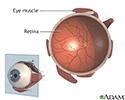Retinal artery occlusion
Central retinal artery occlusion; CRAO; Branch retinal artery occlusion; BRAO; Vision loss - retinal artery occlusion; Blurry vision - retinal artery occlusion
Retinal artery occlusion is a blockage in one of the small arteries that carry blood to the retina. The retina is a layer of tissue in the back of the eye that is able to sense light.
Causes
Retinal arteries may become blocked when a blood clot or fat deposits get stuck in the arteries. These blockages are more likely if there is hardening of the arteries (atherosclerosis) in the eye.
Clots may travel from other parts of the body and block an artery in the retina. The most common sources of clots are the heart and carotid artery in the neck.
Most blockages occur in people with conditions such as:
- Carotid artery disease, in which the two large blood vessels in the neck become narrowed or blocked
- Diabetes
- Heart rhythm problem (mainly atrial fibrillation)
- Heart valve problem
- High levels of fat in the blood (hyperlipidemia)
- High blood pressure
- Intravenous drug abuse
- Temporal arteritis (inflammation of arteries due to an immune response)
If a branch of the retinal artery is blocked, part of the retina will not receive enough blood and oxygen. If this happens, you may lose part of your vision.
Symptoms
Sudden blurring or loss of vision may occur in:
- All of one eye (central retinal artery occlusion or CRAO)
- Part of one eye (branch retinal artery occlusion or BRAO)
The retinal artery occlusion may last for only a few seconds or minutes, or it may be permanent.
A blood clot in the eye may be a warning sign of clots elsewhere. A clot in the brain may cause a stroke.
Exams and Tests
Tests to evaluate the retina may include:
- Examination of the retina after dilating the pupil
- Fluorescein angiography
- Intraocular pressure
- Pupil reflex response
- Refraction
- Retinal photography
- Slit lamp examination
- Testing of side vision (visual field examination)
- Visual acuity
General tests should include:
- Blood pressure
- Blood tests, including cholesterol and triglyceride levels and the erythrocyte sedimentation rate
- Physical examination
Tests to identify the source of a clot from another part of the body:
- Echocardiogram
- Electrocardiogram (ECG)
- Heart monitor for abnormal heart rhythm
- Duplex Doppler ultrasound of the carotid arteries
Treatment
There is no proven treatment for vision loss that involves the whole eye, unless it is caused by another illness that can be treated.
Several treatments may be tried. To be helpful, these treatments must be given within 2 to 4 hours after symptoms begin. However, the benefit of these treatments has never been proven, and they are rarely used.
- Breathing in (inhaling) a carbon dioxide-oxygen mixture. This treatment causes the arteries of the retina to widen (dilate).
- Massage of the eye.
- Removal of fluid from within the eye. An eye doctor uses a needle to drain a small amount of fluid from the front of the eye. This causes a sudden drop in eye pressure, which can sometimes cause the clot to move into a smaller branch artery where it will cause less damage.
- The clot-busting drug, tissue plasminogen activator (tPA).
The health care provider should look for the cause of the blockage. Blockages may be signs of a life-threatening medical problem.
Outlook (Prognosis)
People with blockages of the retinal artery may not get their vision back.
Possible Complications
Complications may include:
- Glaucoma (CRAO only)
- Partial or complete loss of vision in the affected eye
- Stroke (due to the same factors that contribute to retinal artery occlusion, not due to the occlusion itself)
When to Contact a Medical Professional
Contact your provider if you have sudden blurring or vision loss.
Prevention
Measures used to prevent other blood vessel (vascular) diseases, such as coronary artery disease, may decrease the risk for retinal artery occlusion. These include:
- Eating a low-fat diet
- Exercising
- Stopping smoking
- Losing weight if you are overweight
Sometimes, blood thinners may be used to prevent the artery from becoming blocked again. Aspirin or other anti-clotting drugs are used if the problem is in the carotid arteries. Warfarin or other more potent blood thinners are used if the problem is in the heart.
References
Cioffi GA, Liebmann JM. Diseases of the visual system. In: Goldman L, Cooney KA, eds. Goldman-Cecil Medicine. 27th ed. Philadelphia, PA: Elsevier; 2024:chap 391.
Duker JS, Duker JS. Retinal arterial obstruction. In: Yanoff M, Duker JS, eds. Ophthalmology. 6th ed. Philadelphia, PA: Elsevier; 2023:chap 6.15.
Guluma K, Lee JE. Ophthalmology. In: Walls RM, ed. Rosen's Emergency Medicine: Concepts and Clinical Practice. 10th ed. Philadelphia, PA: Elsevier; 2023:chap 57.
Mac Grory B, Schrag M, Biousse V, et al. American Heart Association Stroke Council; Council on Arteriosclerosis, Thrombosis and Vascular Biology; Council on Hypertension; and Council on Peripheral Vascular Disease. Management of central retinal artery occlusion: a scientific statement from the American Heart Association. Stroke. 2021;52(6):e309. PMID: 33677974 pubmed.ncbi.nlm.nih.gov/33677974/.
Patel PS, Sadda SR, Sarraf D. Retinal artery and capillary occlusions. In: Sadda SR, Sarraf D, Freund KB, et al, eds. Ryan's Retina. 7th ed. Philadelphia, PA: Elsevier; 2023:chap 53.
Salmon JF. Retinal vascular disease. In: Salmon JF, ed. Kanski's Clinical Ophthalmology. 9th ed. Philadelphia, PA: Elsevier; 2020:chap 13.
Review Date: 1/29/2024

















